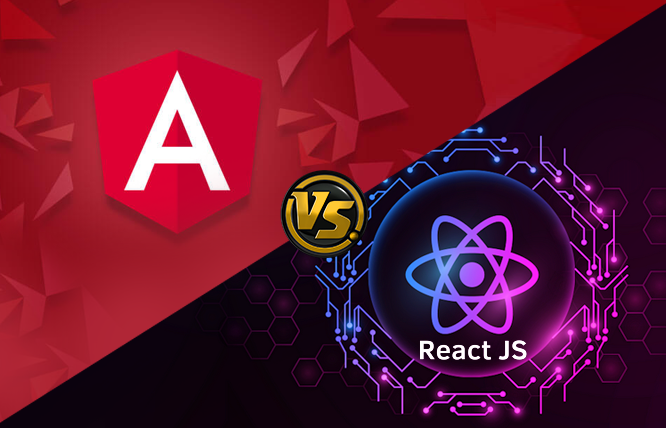This blog provides a detailed comparison between React.js (Library) vs Angular (Framework). We will explore unique features, ideal use cases, and advantages. Additionally, we will look at future trends and developments. By the end, you will have a clear understanding of when to use React.js or Angular for your web development projects.
The competition among web development frameworks and libraries is tough, especially for creating dynamic and interactive interfaces. When it comes to the two most stable frameworks, people always mention React. js and Angular. Neither of them lacks the power or community support, however, to decide on which one to use for your project is challenging. So, without further ado, let’s lay down the foundation with a quick comparison of React JS vs Angular and discuss both of them in detail.
This blog delves into everything you need to know about React js vs Angular. This guide will tell you the difference and help you make an informed decision for your project.
React js vs Angular: Quick Comparison
Here’s a table summarising the key differences between React and Angular:
Feature | React.js | Angular |
Developer | ||
Initial Release | 2013 | 2010 (as AngularJS), 2016 (as Angular) |
Language | JavaScript (JSX) | TypeScript |
Architecture | Component-Based | MVC (Model-View-Controller) |
Data Binding | One-Way | Two-Way |
Performance | Virtual DOM for efficient updates | Real DOM with change detection |
Learning Curve | Moderate | Steep |
Community Support | Large and active | Large and active |
Use Case | SPAs, mobile apps, dynamic interfaces | Enterprise-scale applications, SPAs |
Size | Lightweight | Heavier due to built-in features |
Flexibility | High (works with various libraries) | Moderate (more opinionated) |
React.js: A Component-Based UI Library
React.js is the library from Meta that is used to build dynamic and scalable user interfaces. Released in 2013, it’s in traction due to its focus on modular components and efficient rendering.
React is built on the concept of components. These reusable pieces of code encapsulate UI functionality and data, making it easy to construct complex interfaces from smaller, manageable parts.
Unlike some frameworks, React is primarily concerned with building user interfaces. This streamlined approach makes it ideal for projects where a dynamic and responsive UI is the central focus. However, mastering React development requires dedication and extensive programming knowledge. If this doesn’t fit your skillset, consider seeking help from an Angular Developer or a React.js development company. Do your research and choose the best option for your project, whether it’s the framework, library, or the development team itself.
Advantages of Using React.js
Compared to Angular, React is easier. Its focus on components aligns well with how we naturally think about building UIs.
React offers immense flexibility. It doesn’t enforce a rigid structure, allowing developers to tailor the development process to their specific needs.
React’s virtual DOM (Document Object Model) minimises the number of actual DOM manipulations required for updates, leading to smoother rendering and faster performance.
With Facebook’s backing and a vast developer community, React is ahead in terms of constant innovation.
Angular: A Full-Featured Framework for Complex Applications
Angular is a structural web application framework specially built and designed by Google. Initially introduced in 2010, it has gone a long way and has had some major updates, which cemented its status as a robust framework suitable for complex solutions.
Angular follows the Model-View-Controller (MVC) architecture, where the main components are well-defined based on the data, view, and controller.
Angular goes beyond just UI development. It offers built-in features for dependency injection, routing, and more, streamlining the development process for large-scale applications.
Advantages of Using Angular
- Structure and Scalability: Angular’s structured approach excels in managing complex applications. The enforced organisation makes it easier to maintain and scale large codebases.
- Two-Way Data Binding: Angular’s two-way data binding simplifies data flow management, automatically keeping the UI and underlying data in sync.
- TypeScript Support: Angular leverages TypeScript, a superset of JavaScript, which adds type checking and improves code maintainability.
- Feature Completeness: Angular offers a comprehensive set of features out of the box, reducing the need for additional libraries and tools.
React is best suited for small-scale programs that do not require a complex setup or long developmental period for programmers. Angular, on the other hand, is more suitable for an application with several components and features due to its structure and added support. By knowing your architecture strengths, you can then make an informed decision to build solid web experiences.
Head-to-Head Comparison: Key Differences
While both React and Angular reign supreme in web development, they take distinct approaches. Let’s delve into the key areas where they differ:
Architectural Approach (Library vs. Framework)
- js: Consider React as a multi-functional toolkit. It provides a set of reusable elements for creating user interfaces, but you have control over the overall layout. This adaptability is perfect for smaller projects or ones that need a personalised approach.
- Angular: On the flip side, Angular is a complete framework. It implements a well-defined Model-View-Controller (MVC) framework, which effectively divides data, appearance, and user engagement. This organised method is highly effective in handling intricate applications with numerous components.
Data Binding (One-Way vs. Two-Way)
- js: React employs one-way data binding. This means changes in the UI trigger updates to the underlying data, but not the other way around. This approach requires some additional coding to manage data flow, but it often leads to more predictable and maintainable code.
- Angular: Angular utilises two-way data binding. Any changes made in the UI are automatically reflected in the data and vice versa. This simplifies development initially, but it can become challenging to manage complex data flows in large-scale applications.
Performance & Scalability
- js: React’s virtual DOM reduces the need for direct DOM manipulations during updates. This can result in a more seamless display and quicker operation, particularly in dynamic applications that often have UI updates.
- Angular: Angular’s focus on structure and built-in features can sometimes add overhead compared to React. However, Angular’s scalability is excellent for large applications. Its features, like dependency injection and ahead-of-time (AOT) compilation, can optimise performance for complex web experiences.
The choice between React and Angular depends on your project’s needs. Consider the project’s size, complexity, and desired level of flexibility when making your decision.
Choosing the Right Tool: When to Use React vs. Angular
Picking between React and Angular depends on the project at hand. Here’s a breakdown to guide your decision:
Ideal Scenarios for React.js
- Smaller, focused applications: React’s flexibility shines in projects with a well-defined scope. Its component-based approach makes building dynamic user interfaces so easy.
- Rapid prototyping and experimentation: Need to have quick ideation? React’s ability to fast iteration and experimentation during development makes it a go-to option.
- Integration with existing projects: React plays well with others! It seamlessly integrates with existing libraries and frameworks, making it a great choice for adding interactivity to existing web applications.
Ideal Scenarios for Angular
- Large-scale enterprise applications: Angular’s structured approach and built-in features excel in managing complex applications with many moving parts.
- Long-term maintainability: The enforced organisation of Angular makes it easier to maintain and scale large codebases over time.
- Data-driven applications: Angular’s two-way data binding simplifies development for applications heavily reliant on data flow management.
Case Studies and Examples
- js: Facebook, which developed React, uses it extensively for their web interfaces. Airbnb and Netflix also rely on React for their performance and flexibility. These companies benefit from React’s ability to create dynamic, high-performance UIs.
- Angular: Google, the creator of Angular, uses it for many internal projects. Microsoft uses Angular for Office 365 applications. These organisations value Angular’s comprehensive framework and built-in tools, which help manage large, complex projects efficiently.
Upcoming Features & Updates in React.js
The main focus of React’s development team is on performance and enhancing the developer’s experience. So, we may expect improvements on concurrent rendering, increasing the efficiency of complex applications by enabling React to multitask.
React Server Components is a new feature on the horizon that will enhance server-side rendering and decrease client-side JavaScript usage, which will improve overall performance.
Upcoming Features & Updates in Angular
Angular’s roadmap includes improvements in performance and development tools. Future updates will enhance the Angular CLI (Command Line Interface) with new features to streamline the development process. Angular will also focus on improving the framework’s efficiency with smaller bundle sizes and faster compilation times. Enhancements in Ivy, Angular’s rendering engine, will continue to improve performance and developer experience.
Industry Trends & Predictions
Web development has become much easier with frameworks like React and Angular. A key trend is the focus on performance and developer productivity. Both frameworks are likely to see continued improvements in these areas, not to forget the AI part. AI is a game changer for developers. Moreover, the incorporation of TypeScript in Angular and the growing adoption of contemporary JavaScript in React signify the industry’s movement towards stronger and easily manageable codebases. The need for frameworks capable of efficiently managing scalability and performance will increase as web applications become more intricate.
React JS vs Angular is not a debate; it’s a choice for your web development project. React JS excels at creating dynamic, high-performance user interfaces, whereas Angular offers a strong framework for large-scale applications. Knowing their strengths and future advancements can assist in selecting the appropriate tool for your project.
Conclusion: Building Exceptional Web Applications
The battle between React and Angular is a testament to the power of choice in web development. Understanding the strengths and weaknesses of each framework empowers you to select the perfect tool for the job.
React’s flexibility and ease of use make it ideal for:
- Quickly building dynamic and interactive UIs
- Prototyping and experimenting with new ideas
- Integrating seamlessly with existing projects
Angular’s structured approach and built-in features excel in:
- Managing complex enterprise applications
- Maintaining large codebases over time
- Developing data-driven applications
No matter which option you choose as a technology solution for businesses, React and Angular both have active communities, plenty of resources, and promising futures. You can create exceptional web applications that captivate users and provide unforgettable experiences by utilising the capabilities of these frameworks.
Frequently Asked Questions
React.js is suitable for constructing single-page applications (SPAs), engaging user interfaces, e-commerce platforms, and data dashboards because of its effective rendering and component-driven architecture.
Angular is the best choice for enterprise-level applications on a large scale, including web applications for enterprises and e-commerce platforms.
Unlikely! Both frameworks are constantly evolving and remain major players in web development. The choice will depend on project requirements.
React.js is a JavaScript library used to create user interfaces by utilising a component-focused method. Angular is a robust framework with functionalities such as two-way data binding and dependency injection, designed for extensive applications.
React.js tends to have a lower initial development cost due to its lightweight nature and flexibility. Angular may require more upfront investment due to its comprehensive built-in features.
Have questions or feedback?
Get in touch with us and we‘l get back to you and help as soon as we can!




